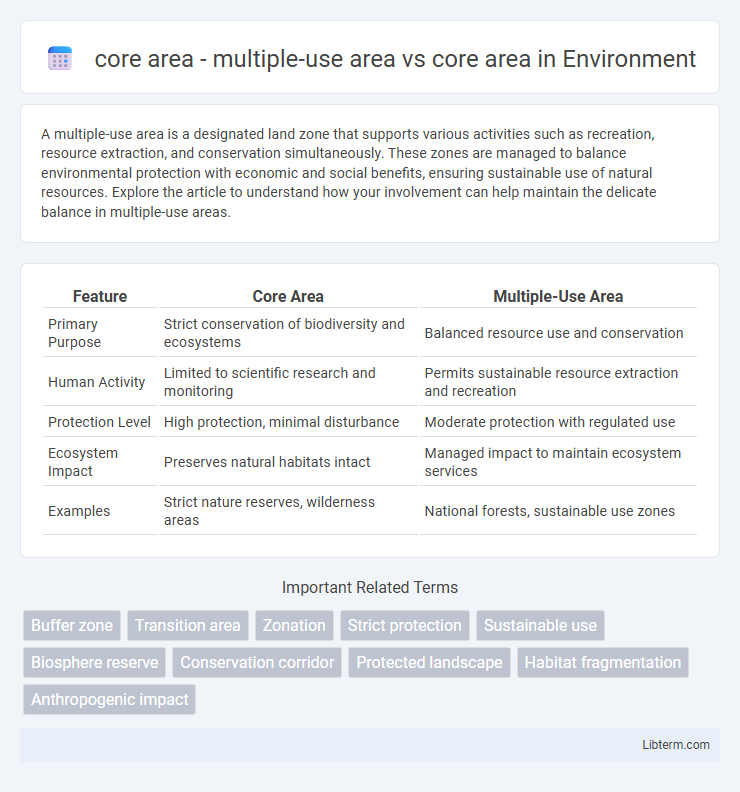A multiple-use area is a designated land zone that supports various activities such as recreation, resource extraction, and conservation simultaneously. These zones are managed to balance environmental protection with economic and social benefits, ensuring sustainable use of natural resources. Explore the article to understand how your involvement can help maintain the delicate balance in multiple-use areas.
Table of Comparison
| Feature | Core Area | Multiple-Use Area |
|---|---|---|
| Primary Purpose | Strict conservation of biodiversity and ecosystems | Balanced resource use and conservation |
| Human Activity | Limited to scientific research and monitoring | Permits sustainable resource extraction and recreation |
| Protection Level | High protection, minimal disturbance | Moderate protection with regulated use |
| Ecosystem Impact | Preserves natural habitats intact | Managed impact to maintain ecosystem services |
| Examples | Strict nature reserves, wilderness areas | National forests, sustainable use zones |
Introduction to Core Areas and Multiple-Use Areas
Core areas are designated regions within protected landscapes that prioritize biodiversity conservation and limit human activities to preserve critical habitats and species. Multiple-use areas accommodate diverse functions such as sustainable resource extraction, recreation, and community livelihood, balancing ecological health with economic use. The clear delineation between core areas and multiple-use areas supports effective land management strategies by integrating strict protection zones with areas allowing controlled human interaction.
Defining Core Areas: Purpose and Importance
Core areas are designated zones primarily aimed at conserving biodiversity and protecting habitats from human disturbances, ensuring the survival of endangered species and ecosystem functionality. Unlike multiple-use areas that permit resource extraction and recreational activities, core areas restrict access to maintain ecological integrity and natural processes. The purpose of defining core areas lies in fostering long-term environmental stability, supporting conservation goals, and mitigating the impacts of habitat fragmentation.
What Are Multiple-Use Areas? Key Characteristics
Multiple-use areas are designated zones within protected lands that allow for diversified activities such as recreation, resource extraction, and wildlife habitat conservation. These areas balance human use with environmental protection by implementing sustainable management practices to maintain ecological integrity. Key characteristics include regulated resource utilization, habitat preservation efforts, and multipurpose land functions to support both economic and conservation goals.
Conservation Goals: Core Areas vs. Multiple-Use Areas
Core areas prioritize strict protection to conserve biodiversity and critical habitats, limiting human activities to ensure ecosystem integrity. Multiple-use areas balance conservation goals with sustainable resource use, permitting managed activities like logging, fishing, and tourism to support local livelihoods while maintaining ecological functions. Effective conservation strategies integrate core areas for species preservation and adjacent multiple-use zones to mitigate human impact.
Biodiversity Protection: Benefits of Core Areas
Core areas, designated for strict conservation without human interference, play a crucial role in maintaining biodiversity by providing undisturbed habitats for endangered species and preserving ecological processes. Multiple-use areas, while allowing sustainable activities like forestry, agriculture, and recreation, often face habitat fragmentation and human impact that can undermine species survival and ecosystem stability. Prioritizing core areas enhances genetic diversity, supports species recovery, and ensures long-term ecological resilience essential for biodiversity protection.
Human Activities in Multiple-Use Areas
Human activities in multiple-use areas are managed to support sustainable resource extraction, recreation, and conservation, balancing ecological health with economic benefits. These areas permit controlled activities such as fishing, tourism, and logging, minimizing environmental impact through regulated access and practices. In contrast, core areas are strictly protected zones prioritizing habitat preservation and biodiversity, often restricting or prohibiting human interference to maintain natural ecosystems.
Zoning Strategies in Protected Landscapes
Core areas in protected landscapes are zones designated for strict conservation where human activities are highly restricted to preserve biodiversity and ecosystem integrity. Multiple-use areas surround core zones, allowing controlled activities such as sustainable resource extraction, recreation, and community livelihood practices to balance conservation goals with local needs. Effective zoning strategies integrate core and multiple-use areas to create buffer zones that reduce human impact on sensitive habitats while promoting sustainable development in adjacent regions.
Managing Conflicts: Conservation vs. Utilization
Core areas prioritize biodiversity conservation by restricting human activities, minimizing habitat disturbance and promoting ecosystem integrity. Multiple-use areas balance conservation goals with sustainable resource utilization, permitting controlled activities like logging, hunting, and tourism under strict management to reduce environmental impact. Effective conflict management requires adaptive governance frameworks that integrate stakeholder participation, enforce regulations, and monitor ecological indicators to harmonize conservation efforts with resource use.
Case Studies: Success Stories and Challenges
Case studies from regions like the Great Barrier Reef and Amazon Rainforest reveal success stories where multiple-use areas balance ecological conservation with sustainable resource use, supporting both biodiversity and local livelihoods. Challenges persist in enforcing regulations and mitigating conflicts between conservation goals and economic activities, often requiring adaptive management strategies and community engagement. Data shows that integrating scientific monitoring with stakeholder collaboration enhances resilience in both core conservation zones and surrounding multiple-use areas.
Future Trends in Area Management and Policy
Future trends in area management emphasize balancing multiple-use areas with core conservation zones to enhance biodiversity and sustainable use. Advances in spatial planning and GIS technology enable precise delineation of core areas to protect critical habitats while allowing regulated human activities in surrounding multiple-use zones. Policy frameworks increasingly integrate adaptive management strategies to respond to climate change impacts and socio-economic demands, ensuring resilient ecosystem services and long-term conservation goals.
core area - multiple-use area Infographic

 libterm.com
libterm.com